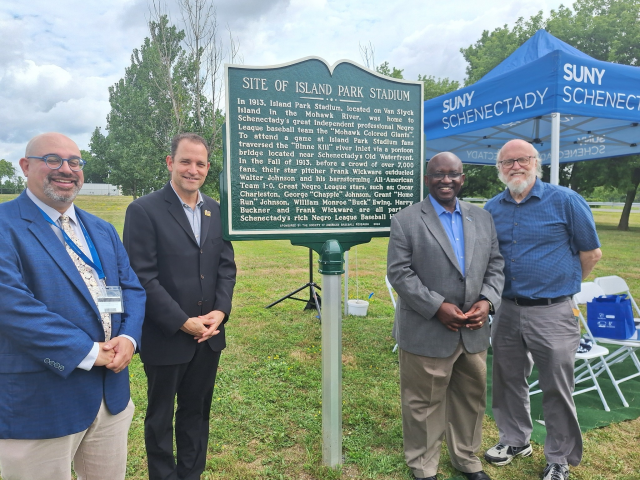
What a joy to be part of an event like the one put on by SUNY-Schenectady last week.
The occasion was a special one as a historic marker, paid for by the American Society for Baseball Research, was unveiled to commemorate Schenectady’s black baseball team, the Mohawk Colored Giants, from the first half of the 20th century.
The more precise reason was to help remember the Oct 5, 1913 game between those Giants and Walter Johnson’s All-Americans, a barnstorming team which traveled all over the country after the end of the Major League season to play exhibition games against the local talent.
Johnson, known as the “Big Train,” was in the prime of his career that year. He was 36-7 with a 1.14 ERA in 1913, but then lost a 1-0 decision to the Giants and their star pitcher, Frank Wickware, before 7,000 fans at Island Park on the Mohawk River. It was an important enough event that the director of the Baseball Hall of Fame and Museum in Cooperstown, Josh Rawitch, showed up last Thursday (July 25) to help SUNY-Schenectady celebrate the occasion.
The story I wrote about the unveiling of the marker in the Daily Gazette was evidently noticed around the country because a few days after it was published I was contacted by Mark Schremmer, a journalist, history buff and baseball fan who happens to live in the same general area of Kansas where coincidentally Wickware and Johnson both grew up. They also were born within five months of each other, Johnson in November of 1887 and Wickware in March of 1888.
Schremmer is working on a book about Wickware, Johnson and professional baseball in the early 20th century, and we both wondered if Wickware and Johnson ever met each other before their Island Park matchup in October of 1913. We both concluded that they probably hadn’t, but Schremmer will be doing more research in that area.
What we do know is that Wickware’s father worked as a janitor at a newspaper in the Gerard, Kansas area in the 1930s and 1940s. Schremmer told me how the proud dad would often ask the sportswriters there if they had ever heard of his son, and the answer usually was no. One day, when Walter Johnson was in town long after his playing days and consented to an interview with the newspaper, the reporter thought to ask him if he had ever heard of Frank Wickware.
According to Schremmer, the story claims that Johnson replied that he had, and he went on to ask the reporter to set up a time when Johnson could come and chat with Wickware’s dad. The two men met a few days later for more than an hour according to a newspaper report, and had a wonderful time sharing their reminisces.
It’s a great story, and as good as I already felt about the historic marker being added to the campus at SUNY-Schenectady, the idea that Walter Johnson was the kind of person who sought out Mr. Wickware to have a conversation about his son made me feel even better.
That day in October of 1913 wasn’t a perfect one. There was trouble and confusion. Life is complicated. But to know that some 20 or 30 years later, Walter Johnson made that kind of effort is refreshing. A little more research and I learned that Johnson would really feel badly about hitting a batter. I also discovered that when a former teammate of Johnson’s, a well-known racist, tried to get a job as a policeman in Chicago, it was the “Big Train” who refused to endorse the idea. It seems he was a thoughtful, genuine good guy, and I’m glad he has such an interesting link to Schenectady.
